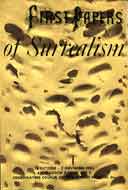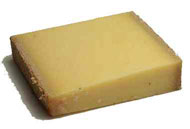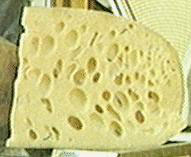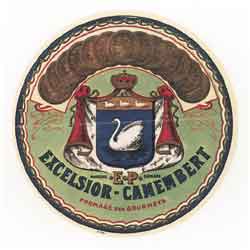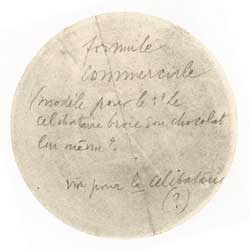|
Marcel
Duchamp Chose Emmentaler Cheese (1942) |
|||||||||||||||||||
|
Response to Thomas Girst's mention of some debate on whether Duchamp used Gruyère or Emmentaler cheese for cover illustration of the catalogue to "First Papers of Surrealism" exhibit in 1942 (Thomas Girst, Shooting Bullets at the Barn, Tout-Fait vol 1/issue 2, notes). We can take it for granted that Duchamp used a slice of Swiss cheese, because cheese showing big eyes ('eye' being the official term for the 'hole' in hard and semi-hard cheese) in a large quantity even when produced elsewhere is always a derivation or variety of Swiss cheese originally manufactured in Switzerland. This is especially true for big eyed Dutch cheese. Messrs Arturo Schwarz and Francis M. Naumann claim(1) that what Duchamp used was Gruyère cheese or so called 'Greyerzer'. As much as I respect the expertise of these two eminent Duchamp scholars, I am afraid that in this particular case they are mistaken. In my book on Kurt Seligmann I wrote that the cover of the catalog shows the profile of some Emmentaler cheese(2). I shall briefly explain why there is little room for debate. Before going any further I simply recommend to stop by at some local cheese dealer. It won't be the first time that blunt empirical (sensual) observation will refute scholastic (rational) conclusion. The finest loaf of Gruyère cheese I saw and tasted in recent times had a shelf life of 12 months, in addition to the approximate six months of ripening before going on sale. It had next to no eyes, just a few haircracks due to its age. And indeed, Gruyère is supposed to have no or only a few and then but small eyes. The very fine cracks are a sign of age and quality. They're officially called 'gläs' - a local, colloquial term I cannot translate. On the other hand, large quantities of eyes of all sizes are typical for Emmentaler cheese. One reason why it is hard to confuse Gruyère and Emmentaler cheese is that the former underwent a smear ripening and the latter a dry-ripening process.
Now I shall go a little bit further, adding some learned information - mainly because I think it is quite entertaining stuff. Swiss-type cheese was originally manufactured in the Emmen valley in Switzerland. Its precursors were mountain cheeses. Gruyère cheese can be understood as such since there is still a (very aromatic) mountain variation produced. So, as a nutritive product, Gruyère cheese may be more ancient than Emmentaler, but this is not the point. The 1000-2000 round eyes - the diameters of which range from less than half an inch to one and a half inches - which we find in one single loaf of Emmentaler cheese are caused by propionic acid fermentation. Yet, the quantum of propionic acid is very low in Gruyère cheese (arithmetic mean of 10.0), but very high in Emmentaler cheese (a. m. of 84.0). Therefore, by means of fermentation Gruyère cheese can develop some eyes, but never a great many of them, and at no point can they be big. Propionic acid fermentation is brought about by short-rod propionic acid bacteria, which occur naturally in the ruman and intestine of ruminants (bon appétit!). Their name is propionibacterium freudenreichii subsp. shermanii. Additional heterofermentative lactic acid fermentation ensures that with Emmentaler cheese the building and growing of eyes will continue where in other (smear ripening) cheeses the process soon discontinues itself. The characteristic eye formation of Emmentaler cheese is due mainly to the presence of carbon dioxide produced by propionic acid bacteria during lactate breakdown. The steep rise in the production of carbon dioxide coincides with the onset of the propionic acid fermentation. Eye formation is a lengthy process. The maximum rate is attained after about 50 days, which is also the time of rapid eye enlargement. Eye formation can be so aggressive that it sometimes continues in the cold room. For further reading I recommend: P. F. Fox (Ed.), Cheese: Chemistry, Physics and Microbiology, Elsevier Applied Science, London and New York 1987, volume 2: Major Cheese Groups, pages 93-120 (chapter 3: Swiss-type varieties, by C. Steffen, E. Flueckiger, J. O. Bosset and M. Ruegg of the Federal Dairy Research Institute, Liebefeld-Bern, Switzerland), from where I got most of the shared information above. The chapter is accompanied by wonderful illustrations that leave very little room for confusion.
Sure, Duchamp would hardly have cared about the name of the cheese. So what does the recognition of Emmentaler lead us to? Well, I believe it mattered to him that it was Swiss cheese, but even more so that it had eyes - and so many of them. Kurt Seligmann, on whose farm Duchamp shot into the wall of the barn, was Swiss (born and grown up in Basel) and (as we can learn from several documents) he liked to make this evident. We know from scattered sources that Seligmann and Duchamp were not the only people present that day, but that the shooting was part, or even the highlight of some outdoor party that other surrealists and American friends from New York were attending as well. It is likely that Seligmann served Emmentaler as a welcome to the guests (together with other kinds of cheese and homegrown Swiss food peculiarities, we can assume). On the front and back cover of the catalogue to the First Papers of Surrealism exhibit the visual juxtaposition is obvious and meaningful. I see the playful contradiction of natural eyes/holes (bacteriologically inflicted, hence on the spot, but 'en retard') in the cheese and the artificial (artistic) holes inflicted forcefully (and from a distance, but ‚at high speed'). None of the two occurrences makes for art in conventional terms, but together they create an artistic, or rather aesthetic, tension. For the substantial differences between art (artificial actions) and nature (natural processes) has always been at the bottom of all creative understanding, especially of artists, as well as "an-artists." Under the condition of art, criteria for substantial and accidental categories can change dramatically from under the condition of nature. Think only of the object and its shadow being substantially different in nature (real world), but substantially identical in painting (aesthetic world). Sometimes art(ificial) actions and natural processes are hard to be kept separate from one another. They can be distinguished (unterschieden), but they cannot be decided upon (entschieden). While the eyes in the Emmentaler grow out of a natural process, it is also a highly artificial thing to happen, since cheese does not exist in nature and would not take on any of its peculiarities without human intervention. Shooting holes into a wall is a thoroughly artificial action, yet based on physical (natural) laws that cannot be denied unless the shooting is declared imaginary. Maybe Duchamp took the gun and shot out of mere boredom. Then his intention was mindless and destructive. Maybe he shot with a picture in mind, and then his intervention had a metaphorical underlining. Maybe he shot out of boredom and happened to make sense out of it later, then a real (literal) action would be transfigured into an imaginary process, or a metaphor. But a metaphor for what? We can say that the manufacturing of cheese is an aspect of art in the old sense of techne. Duchamp always felt himself closer to the artisan than to the artist. Rather than an otherworldly, élitist genius, he was a firm-grounded manufacturer (bricoleur) of holes/eyes, which he imposed upon the well-knit web of conventionalism (by using the essentials of conventionalism, as we know from his conscious or unconscious perceptions of Henri Poincaré's own findings). When Duchamp shot holes into the wall he turned these into eyes to-see-through-with when he punched them out after print. Duchamp enables us to watch and eventually to see through (to theôrein), to get to the theory of what at first seems a mere practical joke on his 'cheesy' Swiss friend and host of the day. It had to be Emmentaler cheese bespangled with eyes, although it would not necessarily had to go by that name. Because only the real 'eyes' of the Emmentaler cheese would the 'real' eyes, (peep holes) punched into the image of the wall shot at, allow to take on the potential of questioning that understanding according to which the limits of what can be grasped is also the limits of what can be seen. (Addendum: In recent issues of Swiss newspapers you could read a short message which translates as follows: According to the U.S. Ministry of Agriculture, eyes in Swiss cheese must not exceed 14 millimeters in diameter. This rule applies as of September 1st, 2000, upon which Mr. Peter Eichenberger, a member of the Verband Emmentaler Switzerland, said that "our experts can produce cheese with eyes of any size you wish." )
|
